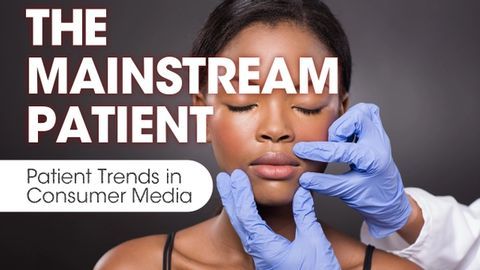- Acne
- Actinic Keratosis
- Aesthetics
- Alopecia
- Atopic Dermatitis
- Buy-and-Bill
- COVID-19
- Case-Based Roundtable
- Chronic Hand Eczema
- Drug Watch
- Eczema
- General Dermatology
- Hidradenitis Suppurativa
- Melasma
- NP and PA
- Pediatric Dermatology
- Pigmentary Disorders
- Practice Management
- Precision Medicine and Biologics
- Prurigo Nodularis
- Psoriasis
- Psoriatic Arthritis
- Rare Disease
- Rosacea
- Skin Cancer
- Vitiligo
- Wound Care
Article
Help for patients with life-altering scars
New technology aims to create a new paradigm in the medical care for survivors of burns and traumatic scars. Jill Waibel shares her experience using lasers for trauma rehabilitation. New non-profit hopes to help injured military heroes and first responders.
Kim Phuc knows how scars and the traumatic experiences that cause them can haunt a person for a lifetime. But thanks to a dermatologist’s commitment to treat her scars, Phuc is not only recovering from her infamous wounds but also is helping others like her.
Many know Phuc from an iconic photograph, showing her and her brothers and cousins fleeing from a Napalm bombing in Trang Bang, June 1972. More than 40 years later, Phuc, the crying, naked child in the middle of the black and white image, still lives with scars that cover 65 percent of her body.
“For many years, my heart was full of hatred, and I wanted to give up. Now, I view my picture from that day as a gift, as it provides me with a larger purpose,” Phuc says. “Through my experiences, I have grown to view my journey as a true gift. I have the opportunity to spread my personal story with others to help inspire and assist other children who have been touched by war.”
Phuc started The Kim Foundation International for child war victims, and she was honorary speaker in March this year at the launch of the Restoring Heroes Foundation, a charity focused on providing America’s wounded warriors with access to world-class medical care for physical and emotional trauma. Lumenis helps support the Restoring Heroes Foundation with research and technology, according to Lumenis’s CEO Tzipi Ozer-Armon. And dermatologists, including Jill Waibel, M.D., of Miami, Fla., are providing what is often free care.
More than cosmetic
Phuc started treatment to address her scars with Dr. Waibel in September 2015. Dr. Waibel, assistant voluntary faculty at University of Miami and chief of dermatology at Baptist Hospital, spoke on using lasers for trauma rehabilitation at the January 2016 Orlando Dermatology Aesthetic and Clinical Conference (Orlando Derm), and was honored during that meeting with a Journal of Drugs in Dermatology (JDD) Humanitarian Award for her work in using lasers to treat patients with traumatic burn injuries.
Burn and trauma survivors have possibly the most painful injuries and the most complex recovery in all of medicine, Dr. Waibel says.
“Of all of these injuries, napalm is certainly one of the worst because it is both a chemical and fire injury at the same time and goes very deep into the skin. Napalm is a flammable liquid used in warfare. It is a mixture of a gelling agent and petroleum or a similar fuel. It was initially used as an incendiary device against buildings and later primarily as an anti-personnel weapon, as it sticks to skin and causes severe burns when on fire,” Dr. Waibel says.
The dermatologist says her treatment for Phuc has focused on multiple laser treatments to improve her pain, pigmentary dyschromias, and to work on texture and flattening the hypertrophic scars.
“Kim has had four laser treatment sessions … in our office, and we treated with a range of laser therapy. The main device we use in treatment of scars is the Ultrapulse fractional ablative laser. Due to Kim Phuc’s deep scars we have used the SCAAR FX, which penetrates 4,000 microns,” Dr. Waibel says. “We measured the depth of her scars using OCT machine to match the depth of her scars with treatment. Additional improvement will be seen in the next six months, as the collagen remodels.”
Phuc’s greatest pain and loss of motion is in her shoulder, where the napalm presumably landed. Most patients with such scarring report substantial improvement in sensory symptoms, including pain, burning and itching, as well as physical mobility, within days to weeks after each treatment, Dr. Waibel says.
“Typically there is rapid improvement in dyspigmentation, followed by gradual improvement in texture,” she says. “Fractional lasers produce tiny injuries in the skin which vaporize the scar tissue and then within a few months these areas heal with new normal collagen. Because we are treating small amounts of skin … it takes a series of treatments. I tell patients it is like boiling water on the stove for tea - you see the steam. We are literally vaporizing off the scar tissue- out with the bad skin and then new skin heals the scarred areas.”
Phuc also is having laser assisted delivery, during which Dr. Waibel uses fractional channels to deliver poly-l-lactic acid (Sculptra, Galderma).
“New collagen synthesis is strongly stimulated by fractional laser therapy. Poly-L-lactic acid is an injectable filler, which is typically injected into the subcutaneous plane for the purpose of facial volume correction. Once implanted the material stimulates fibroblast proliferation and neocollagenesis. By using both laser and, at the same time, Sculptra, we will get a robust renewal of Kim’s healthy collagen,” Dr. Waibel says.
NEXT: Innovative technology
About scar healing technology
Ozer-Armon tells Dermatology Times that Lumenis has invested in research and innovative technology to provide a novel medical procedure aimed at creating a new paradigm in the medical care for survivors of burns and traumatic scars.
“This new technology helps in bringing relief to their suffering of pain, itchiness from pruritus, and limited range of motion and ultimately in helping them integrate back into the normal everyday function. This research has fostered the development of the Lumenis UltraPulse SCAARFX technology, which is the industry’s only customized application with unique unmatched depth of impact in its treatment of hypertrophic thick scars.
The UltraPulse technology is proving to be the best standard of care to these wounded warriors and civilians,” Ozer-Armon says. “This technology has been used by VA and military hospitals for several years already. We have also been collaborating with the VA physicians in training and education programs on the latest UltraPulse technology….”
The foundation’s mission, challenges
The Miami, Fla.-based Restoring Heroes Foundation is a non-profit 501 (c)(3). Its mission is to help the most severely injured military heroes and first responders who have suffered traumatic scars, burns and amputations, according to Carol Novak, a founding board member of the foundation.

Kim Phuc (center) with Dr. Jill Waibel (left of center) at the recent Restoring Heroes Foundation Gala. Pictured with team members of Lumenis, which is helping to support Phuc's treatments.“We do this by providing them access to the most progressive techniques and state of the art medical care,” Novak says. “Veterans who have suffered traumatic wounds can benefit from ablative fractional resurfacing for scar management (Deep FX, Lumenis). This non-invasive treatment, usually considered for cosmetic purposes, has been proven to be an important tool for trauma rehabilitation.”
Novak says that while the scar resurfacing treatment helps diminish pain, increase mobility, and enhance scar appearance for military heroes, it is not covered by insurance. That makes it unattainable for those who have selflessly served.
“Our foundation will lobby for a scar code and support those who need access but cannot financially afford care,” Novak says. “Veteran care will be available in Miami, with Dr. Jill Waibel, the lead medical consultant, and chief of dermatology at Baptist Health System, where additional medical services will be provided for our heroes. Our case managers will manage care plans. The foundation will provide for transportation and housing, as well as non-insured care for the hero and their family.”
Still in the fundraising phase, the foundation expects to be taking patients by November 2016. The near-term plan is to open another location in Boston and long-range plans are to have locations in Chicago, San Antonio, Seattle and San Diego, Novak says.
“By providing training and support of medical professionals, we will expand treatment options and bring facilities closer to these military heroes,” she says.
For Phuc and many with life-altering scars from trauma, getting relief is a long-awaited journey.
“It is a journey and I very much look forward to seeing and experiencing the outcome. I never realized that lasers had the power to heal burn scars,” Phuc says. ”I consider myself fortunate to have been able to receive great treatments and care with laser technology from Dr. Waibel. For dermatologists, my hope is that you are able to provide relief through the best treatment and care possible for as many scar or burn patients. For the burn and scar patients everywhere, I would like to encourage you to not give up as there are options out there.”
Disclosures: Dr. Waibel has done an equipment clinical trial for Alma; is a speaker and researcher for L’Oréal, Sciton/Harvest and Syneron/Candela; is a consultant for Valeant; is a researcher for Lumenis and Sebacia.
For more information about how to get involved, contact carol@restoringheroes.org. Donations can be made through the foundation’s website at www.restoringheroes.org.
Newsletter
Like what you’re reading? Subscribe to Dermatology Times for weekly updates on therapies, innovations, and real-world practice tips.






